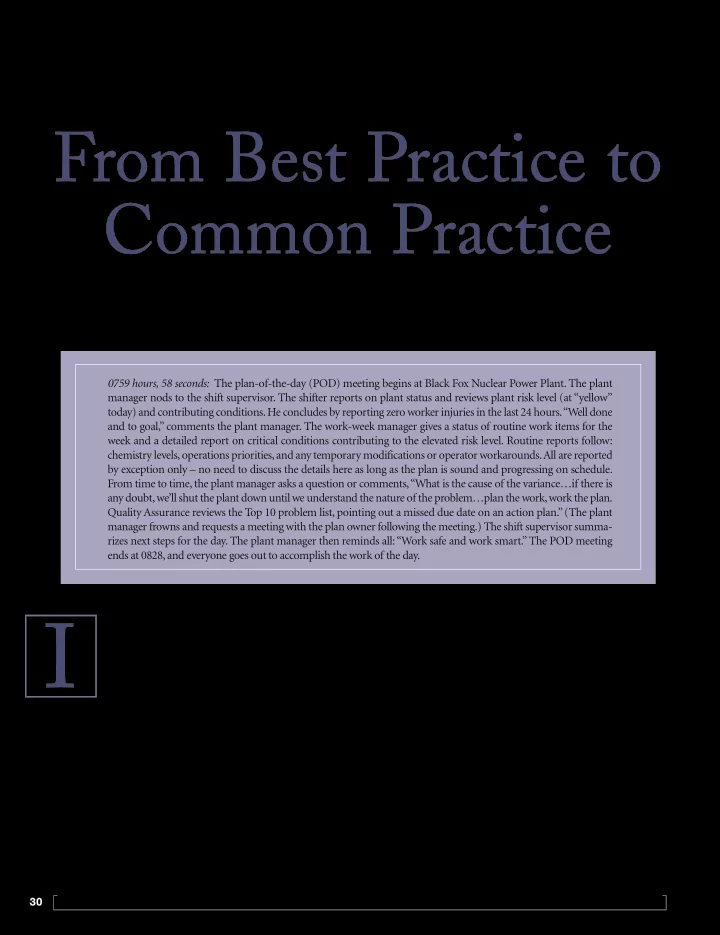

DAILY CHECK-IN FOR SAFETY: From Best Practice to Common Practice By Carole Stockmeier, MHA, CMQ-OE; and Craig Clapper, PE, CMQ-OE 0759 hours, 58 seconds: The plan-of-the-day (POD) meeting begins at Black Fox Nuclear Power Plant. The plant manager nods to the shift supervisor. The shifter reports on plant status and reviews plant risk level (at “yellow” today) and contributing conditions.He concludes by reporting zero worker injuries in the last 24 hours.“Well done and to goal,” comments the plant manager. The work-week manager gives a status of routine work items for the week and a detailed report on critical conditions contributing to the elevated risk level. Routine reports follow: chemistry levels,operations priorities,and any temporary modifications or operator workarounds.All are reported by exception only – no need to discuss the details here as long as the plan is sound and progressing on schedule. From time to time,the plant manager asks a question or comments,“What is the cause of the variance…if there is any doubt,we’ll shut the plant down until we understand the nature of the problem…plan the work,work the plan. Quality Assurance reviews the Top 10 problem list, pointing out a missed due date on an action plan.”(The plant manager frowns and requests a meeting with the plan owner following the meeting.) The shift supervisor summa- rizes next steps for the day. The plant manager then reminds all:“Work safe and work smart.”The POD meeting ends at 0828,and everyone goes out to accomplish the work of the day. I n the nuclear power industry, knowing the status of have some variation of a Plan of the Day meeting.Many health- plant operations and early identification of potential care organizations are applying best practices from high-reliabil- problems is safety critical. At nuclear generating sta- ity industries, such as aviation and nuclear power, to improve tions across the country, like the Black Fox plant (a patient safety and clinical outcomes.Let’s look at the application pseudonym), each day begins with a plan-of-the-day of this high-reliability best practice in the healthcare industry. meeting of plant leaders. A typical agenda includes a review of Daily Check-In for Safety – Healthcare’s Plan emergent safety issues, status of the plant’s Top 10 problem list, of the Day Meeting routine reports,and priorities for the day.The meeting is a lead- ership method for providing awareness of front line operations, The plan-of-the-day equivalent in healthcare is the “daily check- identifying problems, assigning ownership for issue resolution, in”(DCI) for safety.DCI is a deliberate,focused report and con- and ensuring common understanding of focus and priorities versation among leaders about safety events and safety risks. for the day. In this real-time risk assessment—reflecting the words of In Managing the Unexpected , Weick and Sutcliffe (2007) Admiral Hyman G. Rickover, known as the “Father of the describe five defining characteristics of high reliability organiza- Nuclear Navy”(Rockwell, 2002)—the leaders in charge must tions:sensitivity to operations,preoccupation with failure,reluc- concern themselves with the details. If they do not consider tance to simplify, commitment to resilience, and deference to them important, neither will their subordinates. And, leaders expertise.All five characteristics can be found in nuclear power’s in the field must face the facts and make the necessary changes Plan of the Day meeting.In fact,all high-reliability organizations to prevent harm to patients, families, and workers. 30 Patient Safety & Quality Healthcare ■ September/October 2011 w w w . p s q h . c o m
Table 1. Sample of Healthcare Organizations Practicing Daily Check-In Commonly,DCI is a 15-minute meeting of the senior lead- In all five organizations,a senior leader facilitates the meet- er with all department leaders of the organization,and a three- ing,and other senior leaders and all operational leaders partic- point agenda is used: ipate. The meeting occurs in the morning and is scheduled for 1. Look back: Significant safety or quality issues from the 15 minutes. Three organizations—Community Hospital last 24 hours North,Helen DeVos Children’s Hospital,and Wyoming Medi- 2. Look ahead: Anticipated safety or quality issues in next cal Center—hold DCI 7 days a week. 24 hours Most organizations have a fixed order in which partic- 3. Follow-up: Status reports on issues identified today or ipants report, with an “everyone checks-in” expectation days before (no report by exception). When safety-critical issues are identified, all organizations have a mechanism, such as a Healthcare organizations across the country are initiating rapid-response list for urgent issues and/or a top-10 safe- DCI as a high-reliability leadership method.Five organizations, ty list for longer-term issues, for tracking issues, and issue all practicing DCI for at least 1 year, share their insight and resolution.“If the issue requires follow-up, it is written on experiences in this article. The organizations included: a white board in the administrative conference room and • Community Hospital North of Community Health is addressed in the safety briefing the following day,” says Network (CHN)—a 289-bed acute care hospital in Vickie Diamond, president and CEO of Wyoming Medical Indianapolis, Indiana Center. “The issue stays on the white board until it has • Helen DeVos Children’s Hospital of Spectrum Health been resolved.” Wyoming Medical Center also begins DCI (HDVCH)—a 212-bed pediatric hospital in Grand each day by sharing a “safety success story” of an individ- Rapids, Michigan ual who practiced a behavior expectation for error • Virginia Commonwealth University Health System prevention and made a difference. Yakima Valley (VCUHS)—a 779-bed academic medical center in Memorial Hospital and VCU Health System report “days Richmond, Virginia since last serious safety event” as a means of making • Wyoming Medical Center (WMC)—a 207-bed acute explicit what traditionally has been an implicit daily care hospital in Casper, Wyoming goal— creating a safe day —by focusing the staff today on • Yakima Valley Memorial Hospital (YVMH)—a 225- “What will it take today?” to make this a safe patient care bed acute care hospital in Yakima, Washington day. Table 2. Common DCI Practices September/October 2011 ■ Patient Safety & Quality Healthcare 31
Recommend
More recommend